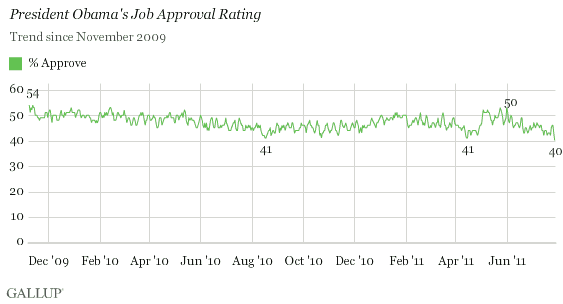PRINCETON, NJ -- President Obama's job approval rating is at a new low, averaging 40% in July 26-28 Gallup Daily tracking. His prior low rating of 41% occurred several times, the last of which was in April. As recently as June 7, Obama had 50% job approval.

Obama's approval rating averaged 46% in June and was near that level for most of July; however, it has stumbled in the past few days, coinciding with intensification of the debt ceiling/budget battle in Washington.
Obama's 40% overall approval rating nearly matches the recent 41% approval Americans gave him for handling the debt ceiling negotiations. Though Americans rate Obama poorly for his handling of the situation, they are less approving of how House Speaker John Boehner and Senate Majority Leader Harry Reid are handling it. Gallup does not include ratings of Congress or congressional leaders in its Daily tracking, and thus, there is no overall job approval rating of Boehner, Reid, or Congress directly comparable to Obama's current 40% overall job approval rating.
Obama's job approval rating among Democrats is 72%, compared with 34% among independents and 13% among Republicans. In the prior three weeks, his average approval rating was 79% among Democrats, 41% among independents, and 12% among Republicans.
Americans' Ratings of the Economy Also More Negative Amid Stalemate
The debt crisis may be contributing to a generally sour mood for Americans that stretches beyond political ratings. For example, Gallup's Economic Confidence Index, which is also tracked daily, averaged -49 July 26-28, down 8 points in the last week and down 19 points since early July. The current index score is the worst Gallup has measured since March 2009.
The index consists of two questions, measuring Americans' ratings of current economic conditions and their assessments of whether the economy is getting better or worse. Currently, 52% say economic conditions are poor, the highest since August 2010. And 75% of Americans say economic conditions are getting worse, a level not seen since March 2009.
Implications
The inability of U.S. lawmakers to agree on the debt ceiling has apparently shaken Americans' confidence in the economy and now seems to be taking its toll on the president's public support, with Obama's approval rating at a new low. As the debt ceiling talks drag on, his ratings, as well as those of Congress (last measured at 18% in early July), could decline further. By the same token, if an agreement is reached, it could restore some degree of public confidence in U.S. political leaders and in the economy.
Explore President Obama's approval ratings in depth and compare them with those of past presidents in the Gallup Presidential Job Approval Center.
Survey Methods
Survey Methods
Results for this Gallup poll are based on telephone interviews conducted July 26-28, 2011, on the Gallup Daily tracking survey, with a random sample of 1,463 adults, aged 18 and older, living in all 50 U.S. states and the District of Columbia.
For results based on the total sample of national adults, one can say with 95% confidence that the maximum margin of sampling error is ±3 percentage points.
Interviews are conducted with respondents on landline telephones and cellular phones, with interviews conducted in Spanish for respondents who are primarily Spanish-speaking. Each sample includes a minimum quota of 400 cell phone respondents and 600 landline respondents per 1,000 national adults, with additional minimum quotas among landline respondents for gender within region. Landline telephone numbers are chosen at random among listed telephone numbers. Cell phone numbers are selected using random-digit-dial methods. Landline respondents are chosen at random within each household on the basis of which member had the most recent birthday.
Samples are weighted by gender, age, race, Hispanic ethnicity, education, region, adults in the household, and phone status (cell phone only/landline only/both, cell phone mostly, and having an unlisted landline number). Demographic weighting targets are based on the March 2010 Current Population Survey figures for the aged 18 and older non-institutionalized population living in U.S. telephone households. All reported margins of sampling error include the computed design effects for weighting and sample design.
In addition to sampling error, question wording and practical difficulties in conducting surveys can introduce error or bias into the findings of public opinion polls.
For more details on Gallup's polling methodology, visit www.gallup.com.
